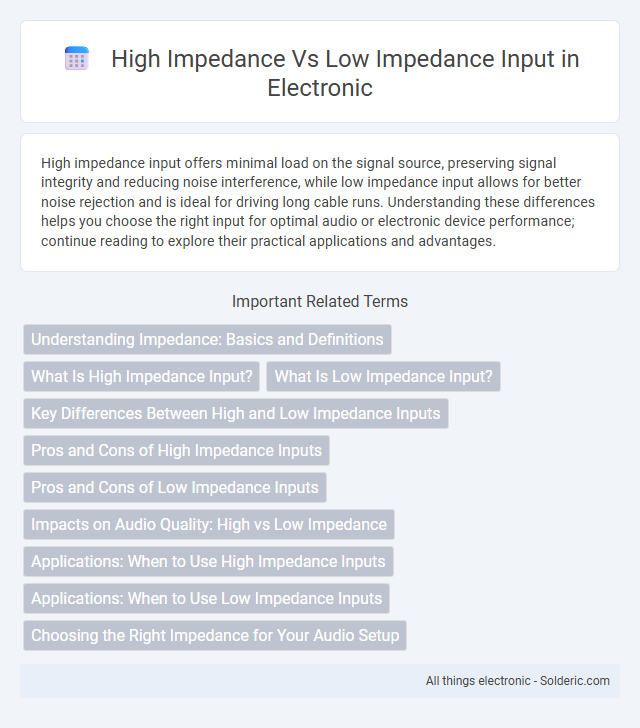High impedance input offers minimal load on the signal source, preserving signal integrity and reducing noise interference, while low impedance input allows for better noise rejection and is ideal for driving long cable runs. Understanding these differences helps you choose the right input for optimal audio or electronic device performance; continue reading to explore their practical applications and advantages.
Comparison Table
| Feature | High Impedance Input | Low Impedance Input |
|---|---|---|
| Input Resistance | Typically > 1 MO | Typically < 10 kO |
| Signal Source Loading | Minimal loading effect | Significant loading effect |
| Noise Susceptibility | Higher noise pick-up | Lower noise susceptibility |
| Use Case | High impedance sensors, passive pickups | Active devices, low impedance sources |
| Frequency Response | May be limited by capacitance | Better high-frequency response |
| Power Consumption | Lower input current | Higher input current |
Understanding Impedance: Basics and Definitions
High impedance input refers to an electrical input with a large resistance to current flow, typically measured in megaohms (MO), which minimizes signal loss and loading effects on the source device. Low impedance input, usually measured in ohms (O) to kiloohms (kO), allows for better noise rejection and is suitable for sources with low output impedance. Understanding impedance involves recognizing the impact of input impedance on signal integrity, frequency response, and matching components for optimal performance in audio, instrumentation, and electronic circuits.
What Is High Impedance Input?
High impedance input refers to an electronic input stage designed to draw minimal current from the signal source, typically characterized by impedance values ranging from megaohms to gigaohms. This high input impedance prevents signal attenuation and preserves the integrity of weak audio, sensor, or instrument signals by minimizing the loading effect on the source. Understanding high impedance input is crucial for Your equipment selection to ensure optimal signal fidelity and performance in audio interfaces, amplifiers, and measurement devices.
What Is Low Impedance Input?
Low impedance input refers to an input stage with a resistance typically below 600 ohms, designed to minimize noise and interference by drawing more current from the source. It provides better signal integrity in professional audio equipment and allows for longer cable runs without significant signal loss. Understanding your audio gear's input impedance ensures optimal matching with microphones or instruments to achieve clear, high-quality sound.
Key Differences Between High and Low Impedance Inputs
High impedance inputs typically feature resistances ranging from hundreds of kilo-ohms to mega-ohms, allowing them to draw minimal current from the signal source and preserve signal integrity. Low impedance inputs, often below 1 kilo-ohm, demand more current but offer greater noise immunity and improved signal stability over long cable runs. These differences affect application suitability, with high impedance favored for delicate sensor signals and low impedance preferred for professional audio and industrial environments.
Pros and Cons of High Impedance Inputs
High impedance inputs minimize signal loading, preserving voltage levels and ensuring accurate signal measurement in sensitive electronic devices like oscilloscopes and audio equipment. However, they are more susceptible to noise interference and can accumulate static charge, potentially causing unstable readings or damage. Balancing high input impedance with proper shielding and grounding techniques is essential to maximize performance while mitigating drawbacks.
Pros and Cons of Low Impedance Inputs
Low impedance inputs provide better noise rejection and can drive longer cable runs without significant signal loss, making them ideal for professional audio equipment and studio environments. However, they require sources with low output impedance to prevent tone coloration and distortion, limiting compatibility with some instruments or devices. Understanding your system's impedance matching is crucial to ensure optimal audio quality and prevent signal degradation.
Impacts on Audio Quality: High vs Low Impedance
High impedance inputs typically preserve audio signal integrity by minimizing current draw, resulting in clearer sound with less distortion and noise, especially when used with passive pickups or high-impedance sources. Low impedance inputs can deliver stronger signal levels and better noise rejection, making them ideal for dynamic microphones or low-impedance instruments, but may load down high-impedance sources, leading to a loss in tonal clarity and detail. Optimal audio quality depends on matching the source impedance to the input impedance, ensuring accurate frequency response and minimal signal degradation.
Applications: When to Use High Impedance Inputs
High impedance inputs are essential in applications requiring minimal signal loading, such as measuring voltage in sensitive circuits, connecting passive pickups in electric guitars, or interfacing with sensors that output weak signals. They prevent signal attenuation and preserve waveform integrity, making them ideal for use in oscilloscopes, voltage probes, and audio equipment. High impedance inputs ensure accurate data acquisition in biomedical instrumentation and high-frequency signal detection where maintaining source signal strength is critical.
Applications: When to Use Low Impedance Inputs
Low impedance inputs are essential in professional audio settings, where they minimize noise and signal loss over long cable runs, ensuring clear sound quality for mixers, microphones, and amplifiers. They are typically used with dynamic microphones and instruments with low output impedance to maintain signal integrity and reduce interference. Choosing low impedance inputs in your audio setup improves compatibility and performance, especially in environments with high electromagnetic interference.
Choosing the Right Impedance for Your Audio Setup
Selecting the appropriate input impedance is crucial for optimizing signal quality and preventing tone loss in your audio setup. High impedance inputs, typically above 1 MO, are ideal for passive guitar pickups and instruments, preserving signal clarity and dynamics, while low impedance inputs, generally under 10 kO, suit microphones and active sources by minimizing noise and interference. Matching your device's output impedance with the input impedance ensures maximum power transfer and reduces signal degradation for superior audio performance.
high impedance vs low impedance input Infographic

 solderic.com
solderic.com